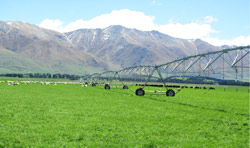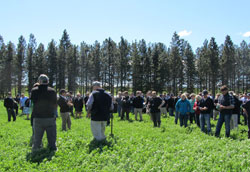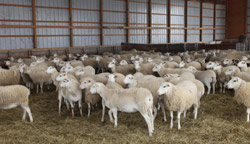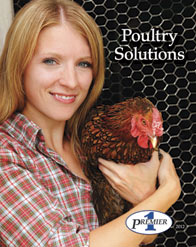|
MESSAGE FROM THE OWNER
Lessons for food producers from the boom in irrigation and alfalfa in New Zealand
I was in New Zealand South Island a month ago on sheep industry business. (I'm a member of the American Lamb Board.) Some years ago I visited the very same places. This time the frequency, scale and sophistication of their irrigation installations was impossible to ignore. Likewise was the sudden interest in the potential of alfalfa. Both gave me pause. Here's why...
Let's consider the irrigation issue first. Why are New Zealand farmers (a place synonymous with green grass, grazing and frequent rainfall) investing in very expensive irrigation equipment (much of it US-made center pivots)?
A. What's the point of irrigating grass in New Zealand?
 Four reasons:
Four reasons:
- They have plenty of fresh water (both surface and subsurface), particularly in the South Island, from melting snow in the mountains.
- Despite the tourism photos, the rainfall in parts of New Zealand is not nearly as consistent year around as many of us think. There are dry periods and there are dry locations—particularly on the east side of the mountains. Ryegrass, long the dominant pasture grass in New Zealand, is very responsive to 2 things—nitrogen and water. If either is short the daily dry matter productivity of ryegrass falls rapidly. Irrigation enables the farmers to ensure that water is not a limiting input—which in turn ensures that the output of milk (from dairy cows) and meat (from sheep and beef cows) from ryegrass is high.
- The price for their products (dairy products, lamb and beef) has gone up sharply due to ever-increasing demand from China and other South Asia countries. So Kiwi farmers calculate that the expense for irrigation (initially and ongoing) will more than offset by higher income/acre/year.
- Because New Zealand can't produce grain as efficiently as the US does, they can't rely on grain feeding to support high milk yields/day from dairy cows or high rate of gains for their lambs and beef cattle when grass growth is limited by too little rain. This is particularly true now that the price of grain, worldwide, is twice that which it was 6 years ago. The best alternative to grain for ruminant animals is to be able to consistently offer them the highest possible forage quality. Irrigation, for the dry areas and dry periods, makes that possible.
B. Why the sudden interest in alfalfa (they call it lucerne)?
 The answer is twofold:
The answer is twofold:
- Unlike ryegrass it will produce high yields without nitrogen fertilizer because it's a legume. And the cost of nitrogen fertilizer has shot upwards—particularly in New Zealand, which doesn't have its own oil or natural gas resources.
- It's more productive per acre than ryegrass—in both dry matter and crude protein. That means more milk/acre/year (from dairy cows) and more meat/acre/year from sheep and cattle. The downside is that it's not as easy to graze as ryegrass without damaging the stand.
However, the surprising thing about alfalfa in New Zealand is that a stand can last decades. I was shown a stand of pure alfalfa planted over 20 years ago. We're lucky to get 4 to 5 years in my part of the Midwest. The difference:
- New Zealand soils are, with some exceptions, well drained. They don't have the high clay content that some parts of the Midwest do. And alfalfa can't tolerate "wet feet"— i.e. poorly drained, compacted soils. The use of heavier hay and silage equipment on clay-based soils may be a reason that alfalfa stand life in the Midwest is less than it used to be.
- The frequent freezing and thawing that damages and/or destroys the crowns of alfalfa roots in the early spring of the Midwest is much less likely in New Zealand.
So the lessons I derived from all of the above:
- Kiwi farmers are responding to the higher demand for food worldwide and thus the higher prices for meat and dairy products by upgrading their systems toward higher productivity per acre and per animal. That costs $$. But if the return is there it's worth doing. They are moving away from lower input/lower output systems (that made sense for them when meat and milk prices were lower) toward higher input/higher output systems. We should consider how best we might do likewise in ways adapted to each situation.
- We need to look more seriously at irrigation here—on grass. Land here is also more expensive than it was 5 years ago. If irrigation enables some to produce more per farm from the same acres, it should be considered.
- We need to rely even more upon legumes. Nitrogen costs aren't going down here in the foreseeable future.
A warning regarding high food prices. While most farmers would like them to continue, there are increasing indications that the economic "boom" in China and other South Asia countries may be replaced by a "bust." The euro crisis will contribute to this by reducing European demand for Chinese goods. This will mean lower worldwide demand for commodities—including food.
Such is the nature of our interconnected world that we in the USA will feel such changes within days.
Best wishes for the holiday season from all at Premier.
Stan Potratz, Owner
PRESS RELEASE
The American Lamb Board Launches Third Lamb Jam Tour
The American Lamb Board kicked off its third Lamb Jam tour in Seattle, WA, October 23, 2011. The Lamb Jam tour cities for FY 2012 will again include Seattle, Boston, Washington, D.C., San Francisco and a finale in NYC. The tour is designed to increase demand for lamb, build fans of lamb in strong lamb markets and to increase awareness about the benefits of American Lamb. The Lamb Jam tour highlights local lamb producers and renowned chefs in each market. Consumers get the opportunity to interact directly with local lamb producers to better understand how lamb is produced and where they can buy it in the market.
The tour showcases the versatility of American Lamb beyond the rack with approximately 20 chefs from each market competing head –to-head for tops honors using local lamb in four cut categories – leg, loin, shank and shoulder. The chef dishes are judged by a panel of local media judges and then sampled by approximately 600 attendees in each market who vote on their favorite dish for the “People’s Choice Award.”
The tour helps break down barriers and misconceptions about lamb and position lamb as approachable and fun. Beyond the tasty lamb samples from local chefs, Lamb Jam also features live music, tattoo parlors, lamb caricature artists, lamb personality quizzes, make your own lamb swag bags and local wine and beer pairings from wine and beer sponsors.
According to ALB Executive Director Megan Wortman, “More than a third of consumers have never tried lamb and many people who have tried lamb only eat it for special occasions or when they eat out. ALB developed Lamb Jam to give people an opportunity to try lamb for the first time or to try different cuts or different preparations. We want people to get more familiar and comfortable with lamb as a great meal option.”
The FY 2012 Lamb Jam tour dates:
Seattle, W.A. – October 23, 2011
www.fansoflambseattle.com
Boston, M.A. – February 19, 2012
www.fansoflambboston.com
Washington, D.C. – May 21, 2012
www.fansoflambdc.com
San Francisco, C.A. – July 16, 2012
www.fansoflambsanfrancisco.com
The American Lamb Board, established in 2002, is a national promotion, research and information organization (national checkoff program) whose purpose is to increase demand for American Lamb and increase the value of American Lamb for all segments of the industry. The Board is appointed by the Secretary of Agriculture and represents all sectors of
the industry. The work of the American Lamb Board is overseen by the U.S. Department of Agriculture and the board's programs are supported and implemented by the staff in Denver, Colorado.
Contact:
Rae Maestas
American Lamb Board
Phone 303-759-3001
Fax 303 759-5832
6300 E. Hampden Ave
Ste 2106
Denver CO 80222
ANNOUNCEMENT
150 Bred ewe lambs from Premier's flock for sale

Dorper/Romanov with a % of Border Leicester and Ile de France in part of them. Born in May/June. All from ewes (and last year's ewe lambs) that pasture lambed without any assistance at all. Weight 90-110 lbs.
Exposed Dec 15 to Dorper/Romanov/Katahdin rams.
Will scan for pregnancy Mar. 1.
Available in lots of ten. $210/head now, $250 Mar. 10 if pregnant.
Contact Premier (info@premier1supplies.com) if you are interested.
COMING SOON
2012 "Poultry Solutions" catalog

Premier's new 2012 "Poultry Solutions" catalog will be mailed to poultry enthusiasts in January. The 40-page catalog will include our full line of poultry items including poultry netting, feeders, waterers, heat lamps, ChickBoxes/other nests, and Premier's hands-on comments and suggestions about using products in the catalog.
Be sure to request the catalog via our website if you're not already on our poultry mailing list. (Note: If you have previously ordered poultry products from Premier, you're already on our mailing list.)
PREMIER TIP
Farm Preparedness Tips
(In case the chickens decide to fly the coop before the cows come home!)
- Ear and neck tags identify animals and their owners. If an animal wanders away from where it should be, it can much more easily be identified and returned to its owner.
- An extra roll of electrified netting is useful in case of a downed fence. A small holding pen can be made with the netting to hold wayward animals while the fence is repaired. Keep fencing supplies (posts, wire, rope/twine and insulators) on hand for emergency repairs.
- Keep on hand a waterproof plastic tote or bucket with lid that contains basic first aid supplies (for both animals and humans) and an emergency contact list. This list should include the veterinarian, backup veterinarian, farrier (horse shoer, if you have horses) and helpful friends/neighbors who can be called for emergency assistance. If someone is taking care of the farm while you're away, this list can be invaluable.
- Maintain evacuation plans for both humans and animals in case of fire, floods or other natural disasters.
- Make sure there is adequate wind protection during extremely cold weather.
- Always have a supply of fresh clean water and feed available to all livestock.
- by Mandy Farrier, Premier Product Consultant
VIP ARTICLE
Caring for Livestock after Disaster
By S. Cotton and T. McBride
(Note: This fact sheet is not designed to provide a recipe for livestock disaster management. Its intent is to start the contemplation process to make you and your operation more resilient so you can survive better, recover faster and possibly mitigate future risks. Each disaster and impact is site specific.)
Many people in the United States are moving back to rural communities. For many reasons, these new rural residents often desire a lifestyle that includes owning horses, cattle, goats, ducks, chickens, sheep, llamas, alpacas and others. As people move closer to their natural resources, they also move farther away from the protection offered by urban and suburban infrastructure. It can be argued that rural living offers improved aesthetics, lower noise levels, and the feel of more “elbow room.” These characteristics come with the responsibility of handling a larger share of emergencies that are often encountered in rural areas.
In most cases, the response time and resources in rural areas are greatly reduced. Handling disasters, those catastrophic events that stretch the capacity of communities, can only be approached with preparedness, pre-planned reaction and post-event mitigation. During a disaster event, rural residents often find their personal safety a large enough challenge without the added burden of caring for livestock. This fact sheet discusses some basic realities of livestock management after disasters occur. Please refer to fact sheets 1.814, Caring for Livestock Before Disaster; and 1.815, Caring for Livestock During Disaster for additional information on this topic.
Priorities
Disasters, by nature, are catastrophic events that overwhelm the ability of individuals, communities and regions. During such catastrophic events, many things get damaged including transportation, communications, emotions and thinking.
When dealing with livestock during emergencies, it is critical to re-establish your priorities. The first priority should be your personal safety and welfare, followed by the safety and welfare of other people, and finally animals and property. If you are safe, you can do more to benefit animals. If you are at risk, so is their welfare and health. Follow official instructions for access and safety when reentering a disaster zone.
Seek and Own
The first logical step in caring for livestock and other animals is to locate, control and provide for those animals. Locating animals often is limited by transportation blockages from the disaster because normal routes may not be available. Your local emergency manager, usually found at an established incident command post, may have alternatives. If the emergency manager is difficult to find, contact local law enforcement for information. As you reenter a disaster area, remember hazards may still occur, including:
| • |
downed power lines. |
| • |
flooded areas. |
| • |
unstable roads and highways. |
| • |
gas and utility leaks. |
| • |
debris and wreckage. |
| • |
vandals and looters. |
Leave an itinerary of your search plan with local authorities and family members. Travel slowly, be alert for hazards, and do not enter unsecured areas. Take identification and livestock ownership documents with you as you search. Official emergency responders often evacuate animals, so check with authorities to see if your livestock has been moved to a holding facility before you enter the disaster zone.
Sensitivity
Animals are like people in that they are emotionally affected by disasters. Often violent impacts of disaster disorient and temporarily alter the behavioral state of livestock. When, and if, you locate your animals, realize that they may be upset, confused and agitated. They need help finding their normal behavioral pattern. Here are some proven techniques for doing this:
| 1. |
Handle livestock quietly, calmly and in a manner they are familiar. |
| 2. |
Wear clothing and use vehicles that are familiar to them. |
| 3. |
If possible, keep or reunite familiar animal groups with each other. |
| 4. |
As soon as possible, place them in familiar settings or one which is quiet, calm and insulated from additional stimuli. |
| 5. |
Soft music and familiar sounds may help calm livestock. |
| 6. |
If possible, clean the animals (i.e., wipe out their eyes, mouths, and nostrils). |
| 7. |
If possible, move animals away from the residue of the disaster. |
| 8. |
Treat wounds of injured animals so their comfort level improves. |
Feed, Safety and Shelter
Animals and livestock often relate security to the familiarity of their surroundings. In some cases, you may be able to return them to familiar surroundings and enhance their recovery. Unfortunately, a disaster often impacts the familiar surroundings altering the landscape’s character, feel, smell, look and layout. To enhance the animal’s comfort level, find another place with similar characteristics. Move the livestock there until you can remedy the damage.
Feed and water are a big part in livestock disaster recovery. In addition to the health and nutrient aspects of appropriate feed and water, livestock can become very picky to eat and drink if their feed and water do not smell and taste familiar. This nervousness is usually greater during and after disasters.
People who show livestock often use Kool-aid® water pails before they haul so that when the animal smells the water at a new location, the Kool-aid® smell is familiar and comfortable. Although not practical before a disaster, many animals will see several holding areas after disasters before finally going home. The Kool-aid® approach to sensory familiarity can reduce stress along the way. Always remember that a calm and quiet shelter serves both physical and emotional needs for livestock.
Quick Facts
| • |
Both livestock and humans can become disoriented after a disaster. |
| • |
Make surroundings as familiar as possible to aid in livestock readjustment. |
| • |
Livestock management priorities should include getting stabilized. |
| • |
Post-disaster recovery often leads to pre-disaster mitigation. |
Reacclimating Livestock
Since the structure and layout of your operation may change because of a natural disaster, or you decide you want to change things to enhance future management, it may be necessary to treat livestock as if they are new to the site. Let them learn the fence layout and the availability of water and feed. Your native forage feed availability may work into this process if the disaster impacted the previous forage supply.
It is important for both animal safety and landscape recovery if you inhibit livestock grazing pressure on disaster-impacted sites until they become stable.
© Colorado State University Extension. 1/04. Reviewed 12/2010. www.ext.colostate.edu
S. Cotton, Colorado State University Extension Pueblo County range management agent and Extension Disaster Education Network (EDEN) coordinator; T. McBride, Colorado State University Adams County Extension director (emeritus), Extension livestock agent, EDEN.
References
| • |
Disaster Preparedness Guidelines for Livestock Owners. Indiana State Public Board of Animal Health. |
| • |
Disaster Preparedness Guidelines for Horse Owners. Indiana State Board of Animal Health. |
| • |
Guidelines for the Development of a Local Animal Care Plan in Emergencies, Disasters, and Evacuations. Heath, Sebastian E. Ph.D. D.V.M. Purdue University, School of Veterinary Medicine. |
| • |
Livestock Handling and Transport. Grandin, Temple. Ph.D., Colorado State University, 1993. |
| • |
Behavioral Principles of Livestock Handling. Grandin, Temple. Ph.D., Colorado State University, 1989. |
| • |
Cattle Handling Safety in Working Facilities. Hubert, D.J. et.al. Bulletin F-1738 Oklahoma State University Cooperative Extension fact sheet. |
Colorado State University, U.S. Department of Agriculture and Colorado counties cooperating. Extension programs are available to all without discrimination. No endorsement of products mentioned is intended nor is criticism implied of products not mentioned.
EMPLOYEE SPOTLIGHT
Mandy Farrier
Mandy Farrier has worked at Premier for 7 years as a sales consultant specializing in horses. She recently switched to the returns/sharpening area, noting what she likes best about working at Premier: "I am able to do something new each day."
Mandy's family includes Matt, her boyfriend of 10 years; her quarter horses Dilly, Gracie, PJ, Romeo and Juliett; a bull calf, Bob; two dogs, Max and Gabby; a cat, Jocie; and a few hens and a rooster.
Her hobbies include her horses and horseback riding, as well as camping, volleyball and reading. She also enjoys cooking, canning and gardening and she has been a Pampered Chef consultant for almost 9 years. (The staff at Premier really enjoys it when she tries out new recipes for us.)
|